
Largest Empires In History
Throughout history, various civilizations have sought to expand their influence and power beyond their original territorial confines. Many such empires achieved great successes before ultimately succumbing to the forces of time and erosion that tend to define all human achievements. This article offers an overview of some of the greatest Empires in human history -- from the British empire to the Xiongnu Empire -- which acted as major linchpins for different cultures across generations. With each boasting its own unique infrastructure, these vast empires offer a glimpse into how civilization has evolved over time and helped shape the modern world.
The 10 Largest Empires in History
- The British Empire - 13.71 million mi2
- The Mongol Empire - 9.27 million mi2
- The Russian Empire - 8.8 million mi2
- The Qing Dynasty - 5.68 million mi2
- The Spanish Empire - 5.29 million mi2
- The Second French Colonial Empire - 4.44 million mi2
- The Abbasid Caliphate - 4.29 million mi2
- The Umayyad Caliphate - 4.29 million mi2
- The Yuan Dynasty - 4.25 million mi2
- The Xiongnu Empire - 3.47 million mi2
- Table of 20 Largest Empires
1. The British Empire - 13.71 million mi2

The British Empire had a profound impact on the world and its history. One can still see its influence today in many aspects of life, from language to culture to international relations. It was formed over several centuries through colonization, war, and trade, with much of its growth taking place during the 19th century. At its peak, it covered an estimated 13.71 million mi2, or around a quarter of the Earth's total land area -- making it by far the largest empire in history both in terms of population and territory. People used to say, "The sun never sets on the British Empire" because the empire consisted of colonies all over the world. However, post World War II, British imperialism began to wane, and the United Kingdom was forced to give up most of its colonial possessions. The British Empire's legacy continues to shape modern-day affairs, with Britain being among one of the most influential nations in the world.
2. The Mongol Empire - 9.27 million mi2
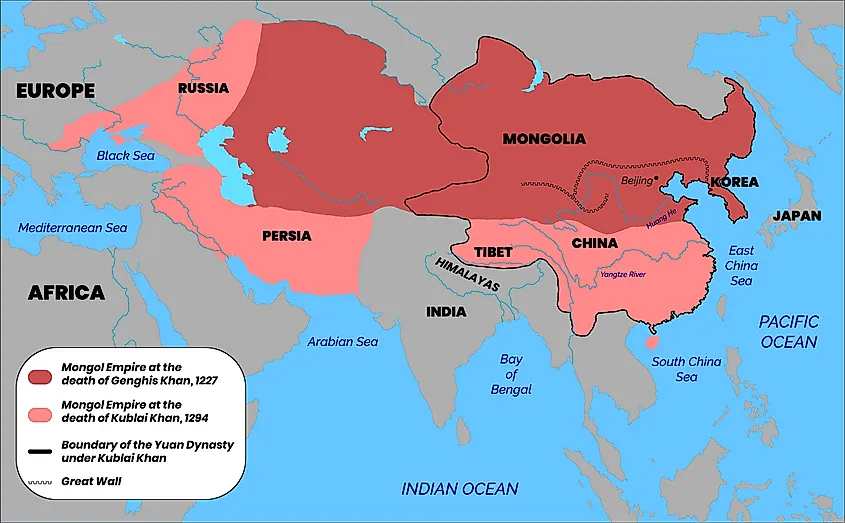
The Mongol Empire was one of the largest empires in history, stretching across Eurasia for an estimated 9.27 million mi2. The empire flourished from 1206 until 1368, playing a pivotal role in world history. The empire began with the unification of Mongol tribes under the leadership of Genghis Khan in the early 13th century. Within about a half-century, the empire controlled a large part of Eastern Europe and most of Central Asia and China. At its height in the mid-to-late 13th century, the borders of the Mongol Empire stretched from the Sea of Japan to western Asia Minor (Anatolia, present-day Turkey). Despite this prosperity, Genghis Khan's passing in 1227 set into motion events that would ultimately lead to the empire's downfall. Today, the Mongol Empire is recognized not only for its brutal warfare tactics but also for its success in unifying different cultures and fostering trade throughout its domain.
3. The Russian Empire - 8.8 million mi2
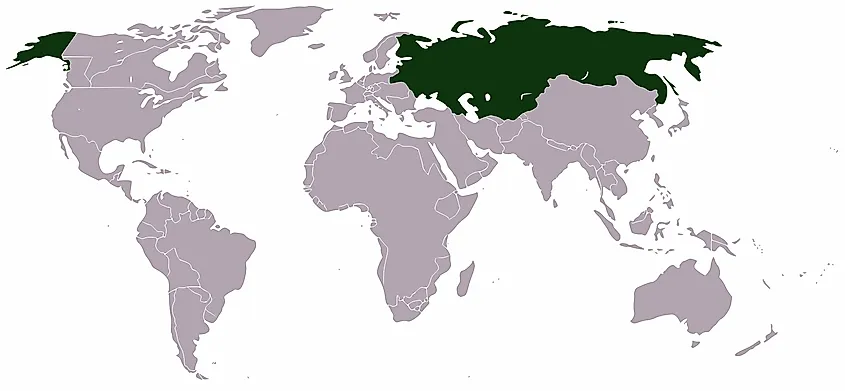
The Russian Empire was an immense political entity that held sway over large parts of Eurasia from 1721 to 1917. At its greatest extent in 1895, it measured 8.8 million mi2. During this period, the Russian Empire became a major European power and played a key role in ceasing Napoleon's annexation of Europe. The population under its governance was 125.6 million people across many territories, religions, languages, and cultures.
On November 2, 1721, the Russian Senate conferred the emperor title to Peter The Great (Peter I), leading to the establishment of the Russian Empire. The Emperor soon began an ambitious campaign to conquer lands far and wide. At its height, the Russian Empire's borders stretched from the northern coast of Asia to the borders of present-day Afghanistan and Iran and from the Bering Sea in the east to the eastern border of Germany in the west. Today, the Russian Federation still possesses much of the territory of the former Russian Empire, though the territory it once held in Central Asia, the Caucasus, and part of Eastern Europe is now part of other countries.
4. The Qing Dynasty - 5.68 million mi2
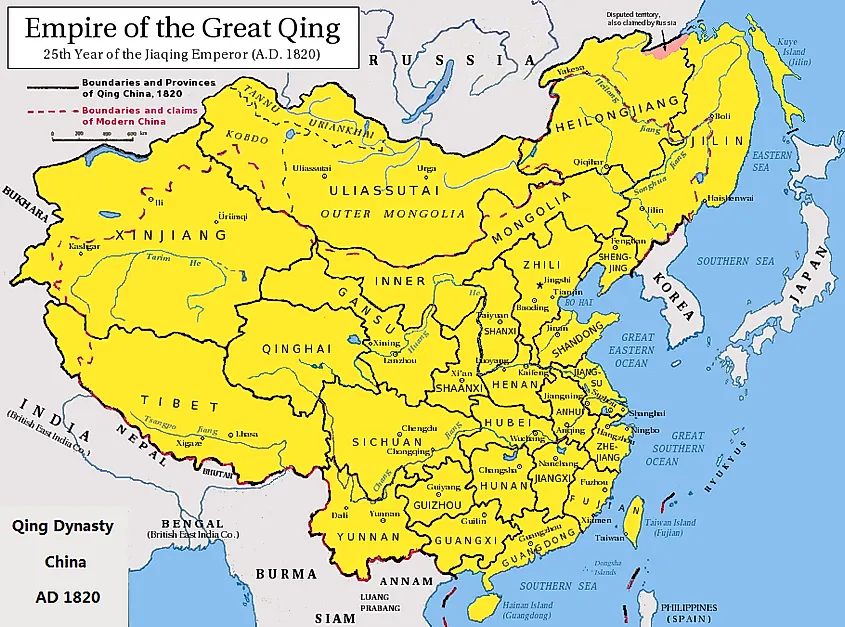
The Qing Dynasty is remembered for its impressive military campaigns, which saw the expansion of Chinese territory. During the Qianlong Emperor's reign, between 1750 and 1790, China's borders were expanded to cover 5.68 million mi2 of land. This included Tibet, Hainan, Taiwan, and large parts of inner Asia that had previously been independent or under foreign control. The expansive campaigns allowed the Qing to extend their rule over an estimated 450 million people -- making them one of the most powerful imperial dynasties in history.
The early Qing period saw relative stability, with population growth leading to increased agricultural output, more trade, and an expansion of cultural life. However, this prosperity would eventually lead to its downfall. Too many people meant too little farmland or employment opportunities, leading to widespread poverty. This discontent provided fertile ground for anti-Qing revolts that threatened the dynasty's stability. Nevertheless, the legacy of the Qing Dynasty's military expansion and power will always remain a part of Chinese history.
5. The Spanish Empire - 5.29 million mi2

The Spanish Empire was one of the longest-lasting and most powerful colonial empires in world history. It emerged from the European Age of Discovery led by Portugal and Spain and soon became a major global superpower.
Spanning nearly five centuries (1492-1976), the Spanish Empire encompassed roughly 5.29 million mi2 at its peak in the late 1700s. Spanish colonies were spread across North and South America, the Caribbean, and some other places. The empire played an influential role in global trade, politics, culture, and economics.
At its height, the Spanish Empire exerted tremendous military and economic power across much of Europe, Latin America, and North Africa. Its legacy can still be felt today. For example, many nations throughout these regions have adopted Spanish law, language, and architecture. Though the Spanish Empire eventually ended with its dissolution in 1976, it remains one of the most impressive and enduring empires in history.
6. The Second French Colonial Empire - 4.44 million mi2
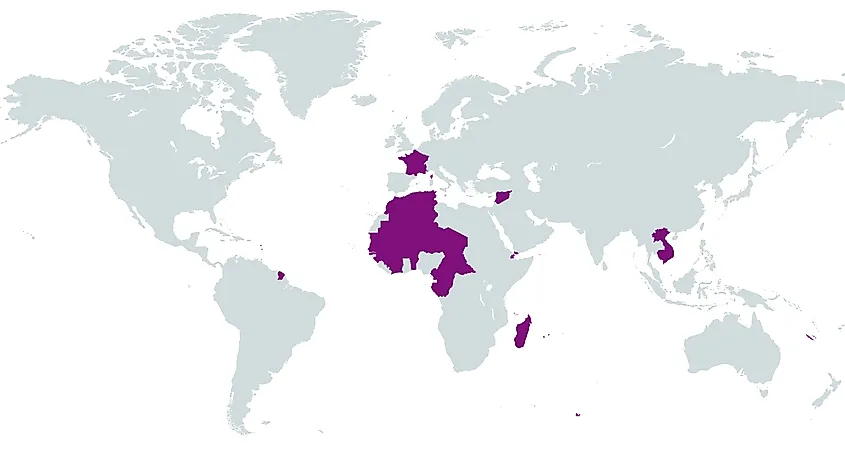
The Second French Colonial Empire was one of the largest in history, with its colonies and dependencies stretching across 4.44 million mi2 at the peak of its power. The Empire began in the early-to-mid 19th century, succeeding the First French Colonial Empire. Like the UK, France once held many colonial possessions in all parts of the world. Its largest possessions were in Africa, while smaller colonies were spread through the Americas, the Caribbean, and the South Pacific.
After World War II, most of these territories were granted independence or autonomy from France, along with their own currencies and governments. Currently, the leftovers of this vast empire are scattered throughout islands in the Atlantic, Pacific, Indian, and Southern Oceans as well as a mainland territory located in South America for a total area of about 47,548 square miles combined. These remaining French territories have unique traditions that reflect both their colonial past as well as local culture, which has been preserved over time.
7. The Abbasid Caliphate - 4.29 million mi2
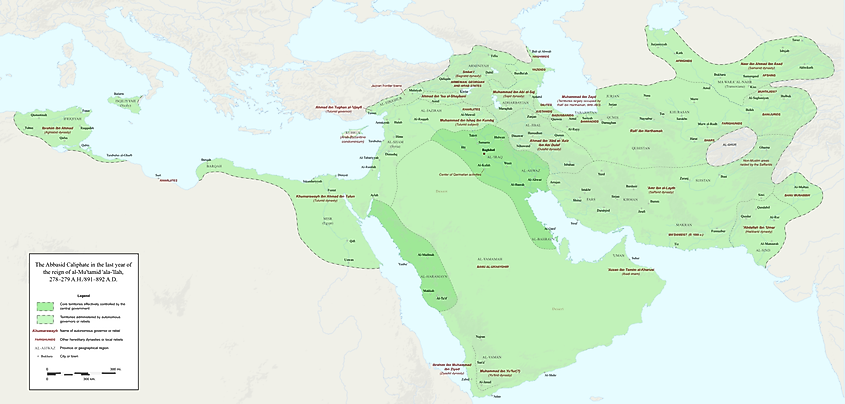
The Abbasid Caliphate was the third Islamic Caliphate to succeed Prophet Mohammed, the founder of Islam. The Caliphate was established in the mid-8th century when the Abbasids overthrew the previous Umayyad Caliphate. It was during the rule of the Abbasid Caliphate that Islam's Golden Age began. At its peak, the Caliphate's territory stretched from the western border of India in the east to the coast of North Africa in what is now Algeria in the west, totaling 4.29 million mi2. The Abbasids ruled for centuries with waning power from the 9th century onwards till their influence was finally eliminated in the early 16th century.
7. The Umayyad Caliphate - 4.29 million mi2
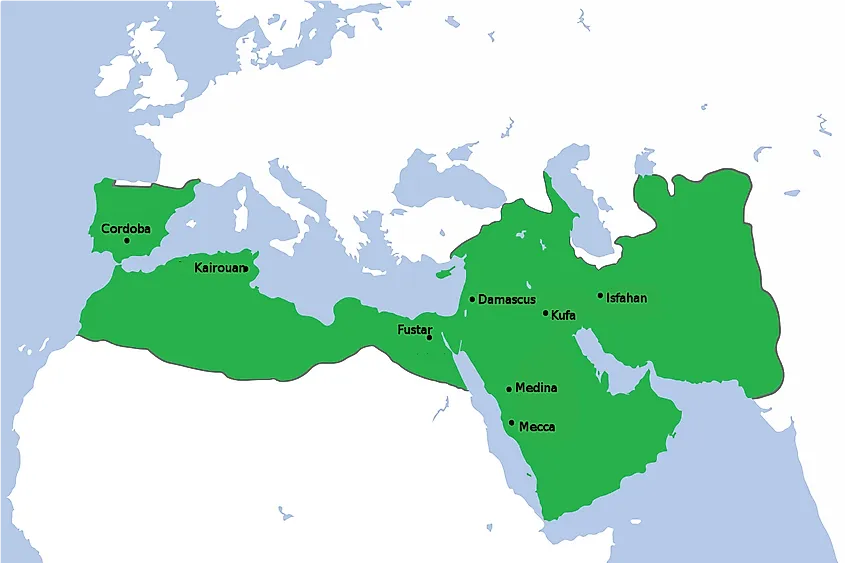
Between 661 and 750, the Umayyad Caliphate was an empire that, at its peak, spanned 4.29 million mi2, encompassing much of the Middle East and North Africa. It was one of the largest empires in history, with 29 percent of the world's population under its rule.
The Umayyad Caliphate had a strong influence on the Sahara region, with nomadic Berber tribes paying homage to the caliph even though they did not have direct control over it. In practice, power lay with local sultans and emirs who governed their own areas within the larger confines of the caliphate. The Umayyad Caliphate was instrumental in introducing Islam to many parts of West Africa and developing Islamic culture during its rule.
9. The Yuan Dynasty - 4.25 million mi2
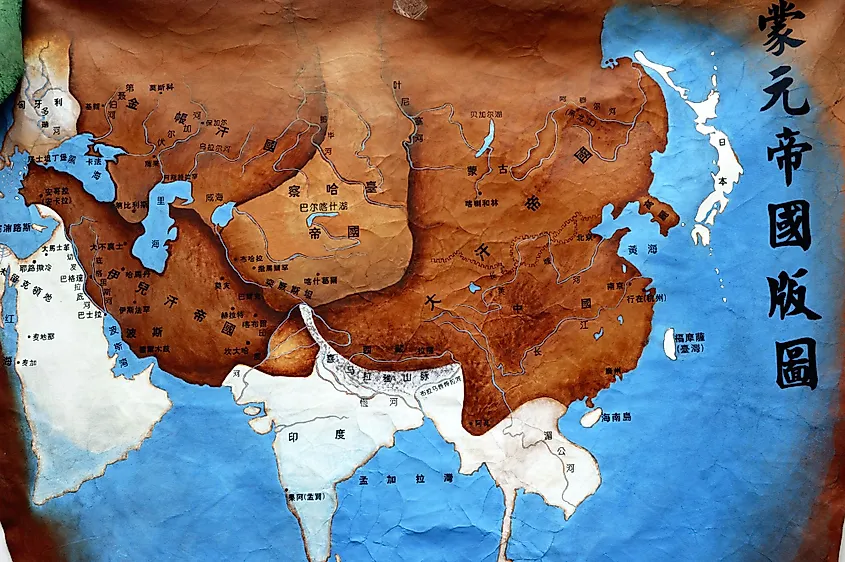
The Yuan Dynasty emerged to rule China as the vast Mongol Empire broke up into separate empires in the mid-to-late 13th century. The Mongol Empire's fifth khagan emperor, Kublai, also known as Emperor Shizu, was the founder of the Yuan Dynasty. The empire lasted from 1271 to 1368, and at its peak, it controlled all of present-day China, as well as Mongolia and the Korean Peninsula, for a total of 4.25 million mi2 of territory. In the mid-14th century, however, its power began to wane until the Ming Dynasty finally replaced it.
10. The Xiongnu Empire - 3.47 million mi2
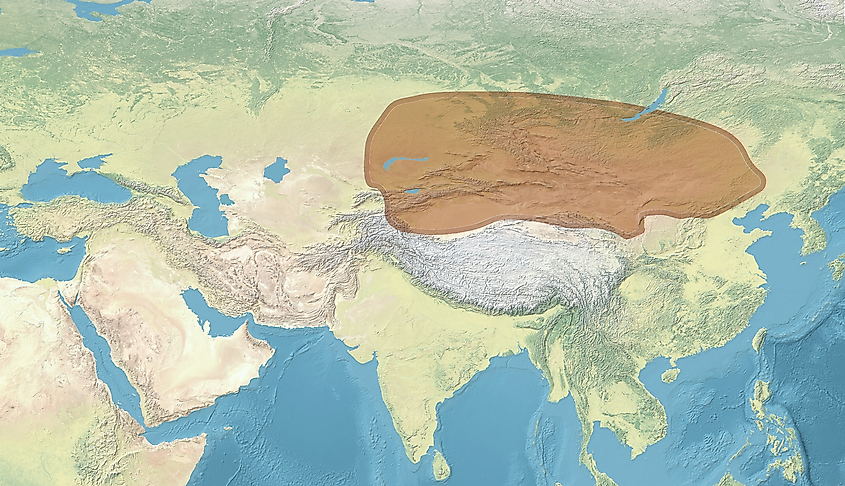
An ancient tribal confederation, the Xiongnu Empire, occupied an area of 3.47 million mi2 at its zenith. Modu Chanyu, a tribal leader, founded the empire in the early 3rd century BC. The tribes constituting the empire were nomadic people who lived in the eastern Eurasian steppe, an area that would later become the domain of the Mongols. At its height in the late 2nd century BC, the Xiongnu Empire's territory stretched from the Manchurian region of present-day China to about the eastern limit of Central Asia and centered on the Mongolian Plateau. The Empire lasted till the 1st century AD when the Han Dynasty of China defeated it, and the confederation split into two.
From the enduring empires of antiquity to the modern-day superpowers, each nation on this list has made its own indelible mark on history. Each one expanded its territory and influence in order to become a dominant force in its respective regions and, in doing so, created new opportunities for cultural growth and economic prosperity. These great empires have profoundly impacted the development of civilization and will continue to be studied by historians for centuries to come.
The 20 Largest Empires In History
| Rank | Name of Empire | Extent (land area in million mi2) | % of world land area |
|---|---|---|---|
| 1 | British Empire | 13.71 | 26.35% |
| 2 | Mongol Empire | 9.27 | 17.81% |
| 3 | Russian Empire | 8.8 | 16.92% |
| 4 | Qing dynasty | 5.68 | 10.91% |
| 5 | Spanish Empire | 5.29 | 10.17% |
| 6 | Second French colonial empire | 4.44 | 8.53% |
| 7 | Abbasid Caliphate | 4.29 | 8.24% |
| 7 | Umayyad Caliphate | 4.29 | 8.24% |
| 9 | Yuan dynasty | 4.25 | 8.16% |
| 10 | Xiongnu Empire | 3.47 | 6.68% |
| 11 | Empire of Brazil | 3.22 | 6.19% |
| 12 | Empire of Japan | 2.86 | 5.49% |
| 13 | Iberian Union | 2.74 | 5.27% |
| 14 | Eastern Han dynasty | 2.51 | 4.82% |
| 14 | Ming dynasty | 2.51 | 4.82% |
| 16 | Rashidun Caliphate | 2.47 | 4.75% |
| 17 | First Turkic Khaganate | 2.32 | 4.45% |
| 17 | Golden Horde Khanate | 2.32 | 4.45% |
| 17 | Western Han dynasty | 2.32 | 4.45% |
| 20 | Achaemenid Empire | 2.12 | 4.08% |
| 20 | Second Portuguese Empire | 2.12 | 4.08% |











